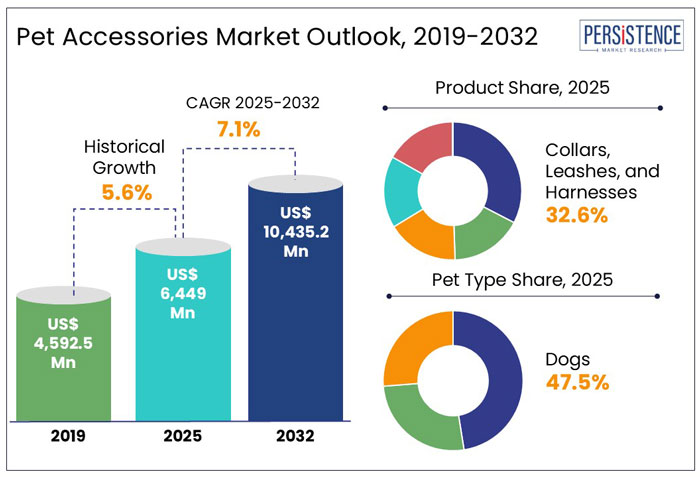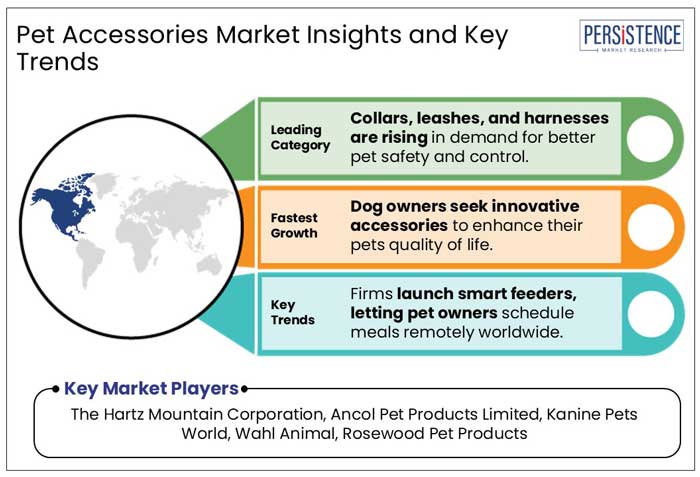Industry: Consumer Goods
Published Date: March-2025
Format: PPT*, PDF, EXCEL
Delivery Timelines: Contact Sales
Number of Pages: 190
Report ID: PMRREP35179
The global pet accessories market size is anticipated to reach a value of US$ 6,449.0 Mn in 2025 and is set to witness a CAGR of 7.1% from 2025 to 2032. The market will likely attain a value of US$ 10,435.2 Mn in 2032.
Gone are the days when a basic food bowl and a simple leash were considered sufficient for furry companions. Today, however, the pet accessories industry is booming, with products like luxury orthopedic beds and pet cameras gaining momentum. The industry is being propelled by pet owners who view their pets as family members rather than just companion animals.
According to a recent survey, around 65% of pet owners would prefer to reduce their personal spending instead of sacrificing the comfort of their pets. Innovation in pet accessories, such as a GPS-enabled smart collar to track lost pets or a cooling vest for a summertime walk, is making life easier for both pets and their owners. Emergence of sustainable accessories like bamboo-based pet bowls and biodegradable waste bags is another key factor anticipated to create new opportunities in the global market.

Key Highlights of the Pet Accessories Industry
|
Global Market Attributes |
Key Insights |
|
Pet Accessories Market Size (2025E) |
US$ 6,449.0 Mn |
|
Market Value Forecast (2032F) |
US$ 10,435.2 Mn |
|
Projected Growth (CAGR 2025 to 2032) |
7.1% |
|
Historical Market Growth (CAGR 2019 to 2024) |
5.6% |
Collaborations between Accessory Brands and Luxury Fashion Houses Surged as Consumers Demanded Exclusive Products
As per Persistence Market Research, in the historical period from 2019 to 2024, the global pet accessories industry witnessed a decent CAGR of around 5.6%. Basic collars, leashes, and feeding bowls were the only pet accessories available in the past. However, the desire for fashionable and high-quality products gradually surged as individuals regarded their pets as important family members.
The historical period saw sophistication and variety in pet accessories. Products such as designer carriers, clothing, collars, and beds attracted fashion-conscious pet owners. They often demanded unique style and a high comfort level for their pets.
Pet accessory companies and luxury fashion brands further joined hands to co-develop designer products. For example, brands like Dsquared2 and Moncler collaborated with Poldo Dog Couture, based in Milan, to come up with exclusive pet apparel by blending pet comfort with high fashion.
Forecast Period to Witness Emergence of Smart Accessories like Automatic Feeder to Take Pet Health to the Next Level
From 2025 to 2032, the pet accessories market is likely to showcase a steady CAGR of 7.1%. The period is anticipated to see the emergence of smart pet accessories like health-monitoring wearables, GPS-enabled collars, and automated feeding bowls.
Automated feeding bowls enable pet owners to control and schedule feeding times in real-time from any part of the world. These help ensure consistent nutrition availability even during the owner’s absence.
The Pitpet Smart Automatic Cat and Dog Feeder, for example, is one such notable example. It can hold around 6 liters of food, which is considered sufficient for nearly 35 days for a cat and 20 days for a small dog. It is equipped with features like airtight design to keep the food fresh as well as up to 9 portion settings every meal.
Wearable technology is another area that is set to see developments. Companies are likely to launch new devices for pets to help determine sleep patterns, activity levels, and similar vital signs to enhance a pet’s well-being. Such innovations are projected to boost the market through 2032.
Pet Owners to Incline toward Online Platforms Providing Custom Solutions as Demand for Niche Items Rises
Booming e-commerce industry is projected to revolutionize the field of pet accessories globally. Online platforms like Chewy and Amazon are likely to increase the accessibility of new accessories, enabling pet parents to purchase a diverse range of products by comparing costs and checking reviews, thereby eliminating geographical barriers.
Another significant benefit of online platforms is their ability to meet niche consumer demands. These platforms provide a wide range of products and services, right from cutting-edge pet care devices to customized pet accessories, unlike brick-and-mortars with limited shelf space.
The emergence of direct-to-consumer brands such as BarkBox and Wild One, for example, has led to the launch of functional and stylish accessories online, meeting demands of modern pet parents prioritizing utility and aesthetics. More such brands are anticipated to come up in the foreseeable future, embracing influencer and social media marketing to enhance customer engagement and reach specific target audiences.
Increasing Product Diversity to Make Manual Inventory Planning Inefficient, Creating Challenges for Retailers
Pet retailers mainly provide a wide range of products like pet furniture and clothing, feeding items, over-the-counter medication, leashes, toys, and travel accessories. It is hence difficult to undertake accurate and efficient inventory planning manually for such a varied range that takes into account both slow- and fast-moving products.
Retailers often struggle to manage their fresh inventories along with slow-moving, larger products like seasonal items, toys, kennels, and furniture. Centralizing planning across all categories, locations, and channels requires an automated, contemporary forecasting and replenishment system, which is the only way to effectively handle that degree of diversity and complexity.
Key Companies to Promote Sustainability Practices to Meet Demand from Eco-conscious Consumers
Many people are unaware of how wasteful pet accessories can be, as toys and plastic bags all contribute to a significant carbon footprint. In North America alone, around 300 Mn pounds of plastic waste is generated from pet products, says the Pet Sustainability Coalition (PSC).
Pet accessory brands, including retailers are hence striving to adopt sustainable practices to cater to the demands of eco-conscious consumers. Popular pet retailers like Petco Health and Wellness Company, Inc., for instance, recently announced its goal of raising its line of sustainable products to 50% by 2025.
The retailer is focusing on sustainably sourced ingredients and materials as well as responsible production with its new goal. At the same time, Petco joined hands with TerraCycle to conduct trade-in events. These would enable consumers to recycle their old pet accessories in exchange for lucrative discounts on new products. Similar initiatives by key companies to support eco-friendly practices in the market are anticipated to create new growth opportunities.
Collars, Leashes, and Harnesses to Gain Traction due to Focus on Pet Safety and Control at Public Places
By product, the collars, leashes, and harnesses segment is projected to hold a share of 32.6% in 2025. Collars and leashes are gaining traction as these act as significant tools to ensure the control and safety of pets during outdoor activities or walks. Rising focus of individuals on responsible pet ownership and pet safety is set to augment the segment.
Companies are capitalizing on this trend by launching durable and reliable cat and dog collars, leashes, and harnesses to help owners keep their pets under control, especially in public spaces. As recreational and outdoor activities with pets become more common, demand for versatile and durable leashes and collars ideal for different environments is rising. Pet owners are anticipated to seek comfortable and highly durable products for jogging, camping, and hiking activities.
Pet feeding accessories, on the other hand, are projected to see steady growth through 2032. Specialized feeding accessories like portion-control feeders, elevated feeders, and slow feeder bowls are set to see high demand. This is attributed to surging desire among pet owners for the optimization of their pet’s well-being. They are also looking for new feeding accessories that would provide portion control capabilities to help maintain their pet’s health.
Rising Humanization of Pets to Propel Spending on New Dog and Cat Accessories Globally
The dog segment is likely to hold a share of 47.5% in 2025. A steady rise in dog ownership across the globe is projected to propel demand for accessories. Owners are constantly demanding a high quality of life for their canine companions. They are prioritizing the health and well-being of their dogs as they are mainly viewed as integral family members. Hence, demand for bedding, feeding, and travel accessories is projected to rise from dog owners.
Cat accessories, on the other hand, are likely to see considerable growth through 2032. The niche and premium categories of cat accessories are set to gain prominence as cat owners look for customized, superior-quality products that reflect their cat’s unique preferences and personalities.

Increasing Focus on Pet Wellness to Create Growth Opportunities in the U.S.
North America is projected to account for a share of nearly 40.3% in 2025. The region is set to be dominated by the U.S. pet accessories market. Over the past 3 decades, pet ownership has skyrocketed in the country with rising importance of pets as sources of emotional support. According to a recent study, around 66% of households in the U.S. own a pet, as of 2024. Most pet owners are millennials (33%), followed by Gen X (25%), and baby boomers (24%).
The most common pets in the country are dogs and cats, with 65.1 Mn households owning dogs and 46.5 Mn owning cats. Small animals such as ferrets, mice, hamsters, chinchillas, guinea pigs, and rabbits are owned by nearly 6.7 Mn households.
The aforementioned numbers are likely to surge in the forecast period, thereby pushing demand for functional accessories like smart feeders, interactive toys, and ergonomic beds. Need for eco-friendly accessories, personalized pet clothing, and travel gear is also projected to increase as a result of the high focus on pet wellness.
Brands in Asia Pacific to Collaborate with Pet Influencers to Promote their Products
In Asia Pacific, demand for human-like accessories and services are constantly rising with the trend of treating pets as children or family members. In 2023, a survey found that pet strollers sales surpassed baby strollers in South Korea.
A key factor attributed to this growth is the rising number of pet influencers. They have garnered millions of followers and hundreds of fans across reputed social media platforms, resulting in several brand collaborations. This factor is not only limited to South Korea, but also developing countries like India.
The pet influencer trend gained impetus in Asia Pacific mainly during the COVID-19 pandemic when various individuals shifted to social media for entertainment and comfort, leading to increasing pet adoption and sharing of pet-related content. Renowned pet accessories and clothing brands are set to partner with such popular influencers to promote their products, which is anticipated to boost sales.
Brands in the U.K. Strive to Launch Affordable Yet Premium Products to Enhance Pet Ownership
In Europe, Germany pet accessories market is projected to witness considerable growth as demand for biodegradable waste disposal products surges with rising focus on environmental responsibility. A few pet owners in the country have also started preferring high-end accessories like energy-saving aquarium filtration and illumination systems, luxury grooming products, nano-coated textiles, and illuminated leashes. Coats, shoes, and clothes are also gaining traction with rising pet humanization.
Germany’s pet wearable market, including GPS tracking devices and gadgets to evaluate pet health, is further estimated to showcase steady growth through 2032. According to the International Trade Administration, the country’s pet wearable industry is set to rise at 14.5% every year from 2023 to 2030, from a value of US$ 1.9 Bn in 2023. It is projected to create new growth avenues in the forecast period.
The U.K. is set to showcase decent growth as several pet care product brands are focusing on exploring new opportunities in the luxury accessories segment. They are focusing on offering superior-quality yet cost-effective products to help improve the experience of pet ownership.
In August 2024, for example, Pets at Home, one of the most prominent pet care companies in the U.K., announced its employment of Stormbrands, a key communications, design, and branding agency for the development and introduction of the retailer’s Noble, an ‘affordable luxury’ accessories line. Pets at Home has recognized a business opportunity in high-end accessories, providing affordable, superior-quality products that give pets the greatest experience possible.
The global market for pet accessories is highly competitive with the presence of various large- and small-scale companies. They are focusing on launching new products to attract a broad consumer base. They are also collaborating with key companies to co-develop unique product ranges. At the same time, they are aiming to broaden their presence across e-commerce platforms to strengthen their position.
|
Report Attributes |
Details |
|
Historical Data/Actuals |
2019 - 2024 |
|
Forecast Period |
2025 - 2032 |
|
Market Analysis Units |
Value: US$ Bn/Mn, Volume: As applicable |
|
Geographical Coverage |
|
|
Segmental Coverage |
|
|
Competitive Analysis |
|
|
Report Highlights |
|
|
Customization and Pricing |
Available upon request |
By Product
By Pet Type
By Distribution Channel
By Region
To know more about delivery timeline for this report Contact Sales

The market is set to reach US$ 6,449.0 Mn in 2025.
The industry will likely be valued at US$ 10,435.2 Mn in 2032.
The industry is set to surge at a CAGR of 7.1% through 2032.
The Hartz Mountain Corporation, Ancol Pet Products Limited, Kanine Pets World, and Wahl Animal are a few key players.
Collars, leashes, and harnesses are a few leading products in the global market.